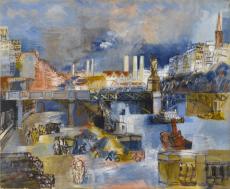


B orn in Le Havre in 1888, Jean Dufy, the younger brother of Raoul Dufy (1877-1953), was, as his brother before him, first put to work in a trading house. Like his brother, he drew assiduously and was strongly affected, during an exhibition in Le Havre in 1906, by a painting by Henri Matisse (1869-1954), whose influence is immediately recognisable in his watercolours. After his military service, Jean Dufy opted definitively for an artistic career and moved to Paris in 1912. Living in Montmartre, he associated with Albert Marquet (1875-1947), Othon Friesz (1879-1949), Georges Braque (1882- 1963), André Derain (1880-1954) and Pablo Picasso (1881-1973), and earned a living by making drawings for a Lyon textile company and then for the porcelain maker Haviland in Limoges. After World War I, he was able to dedicate himself more seriously to painting, while successfully continuing his collaboration with Haviland. His painting, marked at first by accents inspired by Paul Cézanne (1839-1906), rapidly attained a maturity in which the colour, luminous and refined, expressed itself in compositions which were carefully balanced and punctuated by edgy graphic details.
Le Pont de Grenelle, bearing the date 1927, remarkably illustrates the painter’s mastery. The representation in this composition of a smaller version of Frédéric Auguste Bartholdi’s Statue of Liberty in New York, which was offered to the Parisians by the Americans of Paris and placed on the Île aux Cygnes, an artificial island on the Seine downstream from the Eiffel Tower, allows us to identify the site: it is the old Grenelle Bridge, a cast-iron bridge which was replaced in the late 1960s by a modern one. The introduction of the celebrated effigy that stands at the port of New York is perhaps a nod to Dufy’s past as a business traveller, who, coming from Le Havre, seems to have known New York before Paris. The painter chose to look downstream and the steeple on the right is probably that of the Sainte Thérèse chapel on the right bank; on the other hand, he closed the horizon unrealistically, by a series of factory smokestacks and industrial buildings, which were actually located on the left bank, at the Quai de Javel, which was the site of the Citroën car plant, and the neighbouring suburbs. This expressive recomposition turns this vivid painting into a sort of modern allegory of industry and life along the river, a veritable artery of the capital. This interest in industrial activity, which had already been expressed by artists of all stripes during the 19th century, remained unflagging in the case of Dufy and recurred among his contemporaries in the interwar years, Marquet, Albert Gleizes (1881-1953), Roger de La Fresnaye (1885-1925), André Lhote (18851962) and Fernand Léger (1881-1955). The version proposed by Dufy, with its colours and its clean and abridged graphics, reflects the optimism of a period of national reconstruction. A composition combining elements of architecture and expanses of water, punctuated by human silhouettes, Le Pont de Grenelle belongs to Dufy’s repertoire along with his views of the port of Le Havre and Villefranche-surMer painted during the same period.
The younger brother of Raoul Dufy, he moved in 1912 to Montmartre. Until after World War I, when he could paint in earnest, he earned a living by making designs for textiles and porcelain, which he continued to do throughout his career. He quickly reached a mature style, characterised by balanced compositions, sketchy graphic details and transparent, bright tones. In his oil paintings and watercolours, he depicted musicians, flowers, interiors, harbours, landscapes and cityscapes, most especially of Paris.